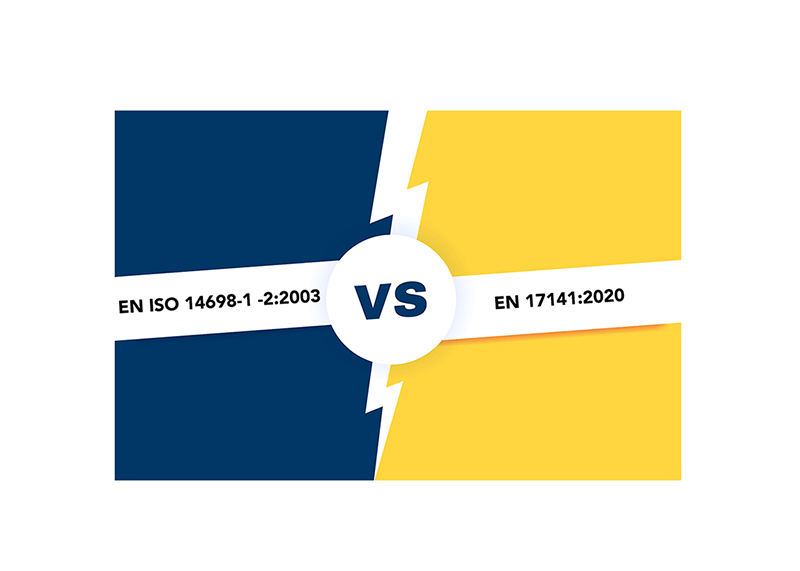In 2020, a vote found EN ISO 14698 no longer suitable for use in Europe, and, thus, it was replaced by EN 17141. Now, there is a push to accept EN 17141 as the international standard, as it is significantly more up to date and applicable than EN ISO 14698.
EN ISO 14698 was last updated in 2003. It contradicts other standards, neglects technological advances, and has a confusing scope. EN 17141 offers a valuable solution to these problems. But how exactly is it different from EN ISO 14698? And how does it directly address the unique problems faced by each industry? Let’s talk about it.
How Do EN ISO 14698-1 & -2:2003 and EN 17141:2020 Differ?
EN 17141 drives major changes in the focus of the standard. It places the emphasis on quality risk management through a contamination control strategy, similar to GMP Annex 1. This plan needs to first establish control then demonstrate it. Normative sections 4 and 5 covering establishing control and demonstrating control, respectively.
Establishing control involves…
- A risk assessment that identifies critical control points (CCPs).
- Assessing GMP regulatory requirements.
- Setting performance requirements.
- Setting action and alert levels.
- Designing a contamination control plan.
Next, demonstrating control involves…
- Monitoring CCPs in accordance with your Environmental Monitoring plan.
- Evaluating data and identifying trends.
- Reviewing the EM plan and its effectiveness.
- Revising the contamination control plan as trends are identified and changes are made to GMP.
This shift is perhaps the most critical change in the standard, but the committee has also adjusted its scope. Information that is covered in other standards was removed, including informative annexes. For example, information on textiles was removed. Other topics were included in the normative sections, such as training.
So what do we find in EN 17141’s informative annexes?
What Do the EN 17141’s Annexes Address?
The informative annexes now provide industry specific information to address the unique concerns faced by different stakeholders. The committee was composed of subject matter experts, as well as people who work in these industries to shed specific light on the issues they are facing. So let’s take a look at what they say!
Informative Annex A: Pharma/BioPharma
The driver behind this industry is product quality and patient safety. Biocontamination presents a major threat to these, so it’s important it’s addressed; however, this is also an incredibly regulated industry. Thus, the best thing this guidance can do for those in this industry is provide clear guidance that resolves conflicts and confusion without adding additional guidance. It mainly refers to existing industry guidance.
Informative Annex B: Medical Devices
The medical device manufacturing industry’s main drivers are also product quality and patient safety. Biocontamination on medical devices can cause serious harm to patients. Currently, contamination of medical devices is prevented through aseptic processing or terminal sterilization; however, these methods do not apply to every medical device. Or they cannot be performed due to the nature of the device.
There are no specific guidelines for medical devices in the existing regulations. There are standards for sterile processing or for sterile medicines, but a profound lack of standards for medical devices.
Informative Annex B resolves this by presenting important guidance on how to navigate microbiological contamination in this industry.
Informative Annex C: Healthcare and Hospitals
Another critical addition in EN 17141 is the subtle distinction between cleanrooms and clean, controlled environments. For example, healthcare and hospitals are often not cleanrooms, but they do have clean, controlled environments. Their main concern is infection control. But they are also concerned about:
- Cross contamination,
- Isolation for the immunocompromised,
- Sterility,
- Chemotherapy and other radiopharmaceuticals,
- Isolation of unknown infection (biosafety),
- And instrument sterilization.
There is a need for clean, controlled environments in the operating room, isolation wards, immunocompromised wards, pharmacy aseptic compounding, and labs. Previously, guidance on how to navigate clean, controlled spaces that aren’t cleanrooms were relatively ignored, EN 17141 fixes that and gives specific standards for healthcare and hospitals in this annex.
Informative Annex D: Food Manufacturing
Food manufacturers are facing the need for quality of freshness, health, and nutrients. They also are not always cleanrooms, but often a clean, controlled environment. They have a variety of unique challenges they face in this space:
- Pathogens can cause death or illness when found in food.
- They need to maintain high levels of food quality to secure the consumer’s choice.
- Spoilage in retail outlets can lead to economic loss, so they need to improve food’s longevity.
Food manufacturers often have some level of moist conditions, which can cause the spread of bacteria, yeasts, and molds. To prevent this contamination, manufacturers need to keep the air around the food free of contaminants, but they also need to look at surfaces. Thus, a heavy focus is placed on cleanzones and clean work surfaces.
By controlling contamination, food manufacturers can avoid pasteurization or flash freezing, which kills contamination. They could also avoid adding unnecessary artificial preservatives. The ultimate goal of the provided standards is to:
- Lower manufacturers’ cost of production and increase yield.
- Decrease foreign microbiological content used as preservatives.
- Eliminate microbiological pathogenic contamination, thus eliminating health hazards.
- Increase shelf life of food products.
- Improve the visual presentation of the food.
What Is The Future Of The Industry?
The simple reality is that EN 17141 provides clarification and straightforward standards where En 14698 has become outdated and obsolete. While there are still a number of steps the committee needs to go through, we see the merits of adopting EN 17141 as an international standard through ISO.
We discussed this topic, along with others, in our monthly free webinar. If you want to stay up to date on changes made in this industry and get answers from the subject matter experts themselves, join us for our next webinar! Sign up here.


